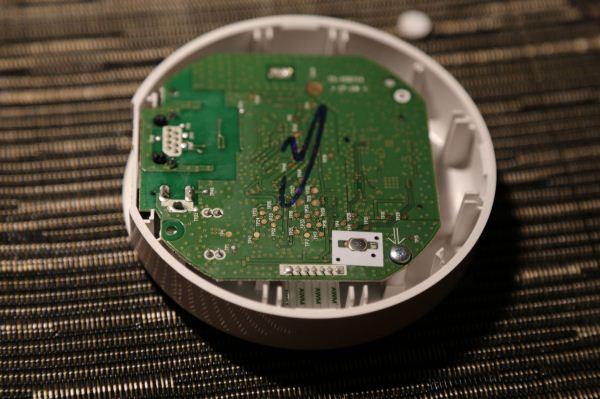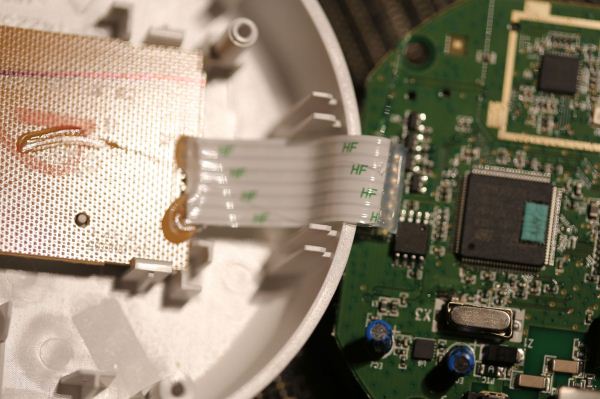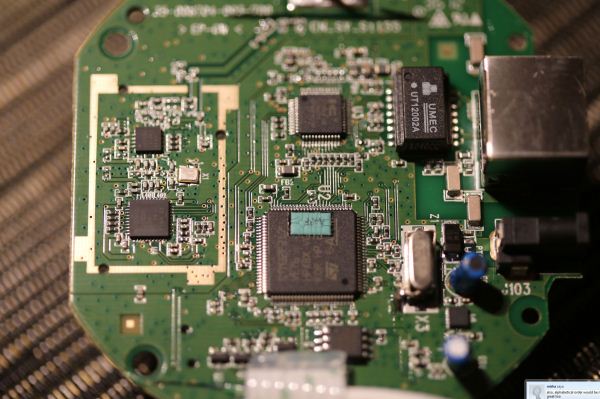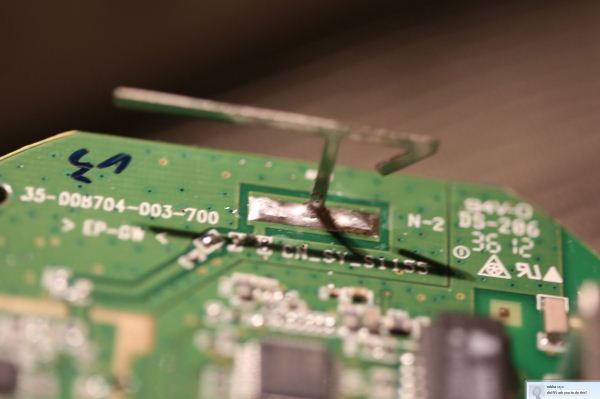Philips Hue: Automated Home Lighting Gets Colorful
by Ashu Joshi on March 1, 2013 12:50 AM EST- Posted in
- Gadgets
- Home Automation
- Philips
- Hue
- Lighting
Teardown and Design
The Hue Bridge has two screws that you need to remove before you can pop off the back. Even with the screws out, popping the back off is tricky—it has an interesting snap-in mechanism. Here’s what the back looks look like; the two white “feet” at the bottom are covering the screws. I used tools from iFixIt to get this open.
Once you open it up, you can see the back side of the PCB, and the snap-in connecter I mentioned earlier.
The PCB is connected to the front of the Bridge using a ribbon connector. This cable provides the power and signals for the LEDs and the Link button.
The main PCB has the two primary components of the Hue Bridge, an ST Microelectronics STM32F217VE Microcontrollerand a Texas Instruments CC2530 ZigBee Controller.
There is also an RF range extender (CC2590) coupled to the CC2530. The STM MCU has an integrated Ethernet controller, but as a whole the design has very few components. It’s clear that the majority of the cost for the Starter Pack is in the bulbs and not in the Bridge. (Based on the total kit price, the Bridge is $20 more than the cost of the three bulbs, though of course that leaves plenty of room for profit margins.) The image below shows the antenna for ZigBee:
I’ll cover the technology behind the Hue Bridge in a moment, but the choice of microcontroller for this design is a clear indication that this is primarily a purpose-built device. That is, it does not have the horsepower to extend to different types of applications due to the limitations of the CPU and the amount of memory. Nonetheless, it is well suited for the function at hand; let’s look at the specifics of the technology behind Hue before we get into a discussion of what it can and cannot do.





















94 Comments
View All Comments
nathanddrews - Friday, March 1, 2013 - link
The difference being, of course, that LIFX uses a master 802.11n bulb to control all the 802.15.4 slave bulbs instead of an extra controller box plugged in elsewhere. Also, unlike the Philips system, you have to not just have the app but also must be on the network in order to control the bulbs as each of the LIFX slave bulbs will only work with the master bulb which is behind your network password. The Philips system has no such security, which immediately removes it from the running, IMO.xdpfddai - Friday, March 1, 2013 - link
This is incorrect. The Phillips controller hub is behind your wireless network, so whatever security you have on that applies. They are both secure. 802.15.4 also applies to ZigBee.nathanddrews - Friday, March 1, 2013 - link
The controller hub/bulb isn't in question, it's the slave bulbs that I'm concerned about. The article probably needs to flesh out this comment better:"Given the use of the ZigBee controller along with the fact that there is no configuration on a per device level to connect it to the network (e.g. you just buy additional bulbs and they apparently broadcast and communicate with any and all Hue devices), we would assume that 50 lights and a single Bridge is about as far as you'll be able to go within a single area. Conceivably, there could also be problems if your immediate neighbor also picked up a Hue—how would the lights know to talk to your Hue network and not his? This is both the blessing and curse of going with an easy to configure technology."
If your neighbor can buy a Hue Hub and just start controlling your bulbs, then it is certainly NOT secure. LIFX appears to have locked out this capability simply by using the built in 802.15.4 encryption, so perhaps this is a case of LIFX applying the encryption and Philip not.
"We have considered security. The WiFi connection will use the standard security set-up that you are currently using. Mesh networks based on 802.15.4 will encrypt packets using AES-128. Higher network stack layers will need to handle exchange of security keys and deal with problems like "replay attacks". In short, your lights will be as secure as your home wifi network."
xdpfddai - Friday, March 1, 2013 - link
Just RTFM on ZigBee and 802.15.4. In short, they both use 128bit crypto. You don't have to worry about it as the end user either. If anyone is going to do their due diligence, it's going to be Phillips. You need to realize that both LIFX and the Phillips implementation are 802.15.4.This Guy - Saturday, March 2, 2013 - link
Last time I checked zigbee uses a four digit, numerical key to identify mesh networks. Not exactly secure.iamezza - Sunday, March 3, 2013 - link
So someone could hack into your light system and screw with your lights? Not really a big deal TBH.SodaAnt - Friday, March 1, 2013 - link
I think that the technology is almost there, but the price isn't. For this to be a reality for normal users, each bulb would need to be in the $10-$20 range, and would only really gain widespread acceptance if each bulb was below $10. To me, these really only make sense if you have a small apartment or something and can easily light it with 3-5 bulbs total, and even then its a significant expenditure.This Guy - Saturday, March 2, 2013 - link
The zigbee radio's and high output RGB LED's are a significant additional cost (compared to the $10 RGB IR controlled globes you can but for $5 - $10). Neither item is mass produced on the scale that truely reduces their price.Ualdayan - Tuesday, March 5, 2013 - link
There are cheaper Zigbee bulbs. I saw on another site somebody mentioned Limitless LED that are only $57 for 2 bulbs+wireless bridge for phone/tablet, and $19 per additional bulb. Now - they only offer a 3 year warranty (Hue is 5 years I believe), and from what I've read their software isn't as 'fun' as Hue's. Eg nothing like Hue's ability to set a 'beach' mode, 'reading' mode, or 'sunset' mode. Let's face it - nobody needs these - they're just for fun. With that in mind I think personally even at double the price I'd go for the ones that have software that is more 'fun'.I just have too many other things I know I should replace before having fun with lightbulbs.
Rick83 - Friday, March 1, 2013 - link
Except, not really, because at that price it's going to have an exclusive audience.Something that I did't quickly find in the review is the quality of the actual bulbs. (Considering that this is the business end of the product, I should be able to?)
The controller itself certainly is interesting, but then it's "merely" Zigbee in a box.
A comparison to similarly specced non-smart LED lights would have given a better price differential for the smartness.
Also, I can't really come up with a use case. For me, the light in a room is always tailored to the room. The only reason to use this kind of semi-smart light, is if you have limited rooms, and need to multipurpose them, by varying the lighting. Then of course, you don't need nearly 50 lights.
To me this looks like the answer to a question nobody asked.